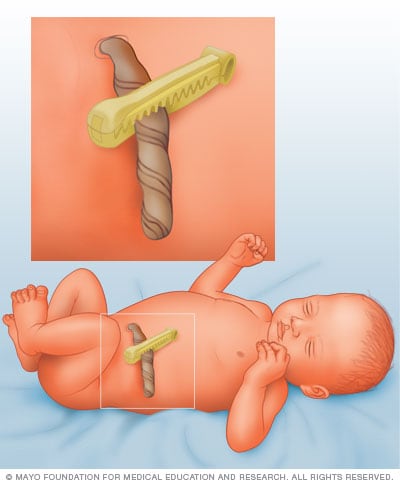
Umbilical cord care: Do’s and don’ts for parents
Umbilical cord care: Do’s and don’ts for parents
A newborn’s umbilical cord stump typically falls off within about two weeks after birth. In the meantime, treat your baby’s umbilical cord stump gently.
By Mayo Clinic Staff
Wonder how to care for your newborn’s umbilical cord stump? Follow these tips to promote healing.
Why your baby has an umbilical cord stump
Umbilical cord at birth
Umbilical cord at birth

Umbilical cord at birth
After birth, the umbilical cord is clamped and snipped.
During pregnancy, the umbilical cord supplies nutrients and oxygen to your developing baby. After birth, the umbilical cord is no longer needed — so it’s clamped and snipped. This leaves behind a short stump.
Taking care of the stump
Your baby’s umbilical cord stump dries out and eventually falls off — usually within one to three weeks after birth. In the meantime, treat the area gently:
- Keep the stump dry. Parents were once instructed to swab the stump with rubbing alcohol after every diaper change. Researchers now say this might kill bacteria that can help the cord dry and separate. Instead, expose the stump to air to help dry out the base. Keep the front of your baby’s diaper folded down to avoid covering the stump.
- Stick with sponge baths. While there’s no harm in getting the stump wet, sponge baths might make it easier to keep the stump dry.
- Let the stump fall off on its own. Resist the temptation to pull off the stump yourself.
Signs of a problem
During the healing process, it’s normal to see a little blood near the stump. Much like a scab, the cord stump might bleed a little when it falls off.
However, contact your baby’s doctor if the umbilical area oozes pus, the surrounding skin becomes red and swollen, or the area develops a pink moist bump. These could be signs of an umbilical cord infection. Prompt treatment is needed to stop the infection from spreading.
Also, talk to your baby’s doctor if the stump still hasn’t separated after three weeks. This might be a sign of an underlying problem, such an infection or immune system disorder.
Get the latest health information from Mayo Clinic’s experts.
Sign up for free, and stay up to date on research advancements, health tips and current health topics, like COVID-19, plus expertise on managing health.
To provide you with the most relevant and helpful information, and understand which
information is beneficial, we may combine your email and website usage information with
other information we have about you. If you are a Mayo Clinic patient, this could
include protected health information. If we combine this information with your protected
health information, we will treat all of that information as protected health
information and will only use or disclose that information as set forth in our notice of
privacy practices. You may opt-out of email communications at any time by clicking on
the unsubscribe link in the e-mail.
Thank you for subscribing
Our Housecall e-newsletter will keep you up-to-date on the latest health information.
Sorry something went wrong with your subscription
Please, try again in a couple of minutes
Feb. 08, 2022
See more In-depth
Products and Services
.
Stay connected with us on social media platform for instant update click here to join our Twitter, & Facebook
We are now on Telegram. Click here to join our channel (@TechiUpdate) and stay updated with the latest Technology headlines.
For all the latest Health News Click Here
For the latest news and updates, follow us on Google News.

